APC308 Financial Management: Valuation and Investment Analysis Report
VerifiedAdded on 2023/01/10
|15
|3794
|35
Report
AI Summary
This report analyzes key financial management concepts, focusing on valuation techniques and investment appraisal methods. The report begins by exploring three primary valuation techniques: the price/earnings (P/E) ratio, the dividend valuation method, and the discounted cash flow (DCF) method, providing detailed explanations and practical examples for each. It then offers a critical evaluation of these techniques, highlighting their strengths and weaknesses. The second part of the report delves into investment appraisal techniques, including the payback period, accounting rate of return (ARR), and net present value (NPV), with calculations and interpretations. The report also provides an application of different investment appraisal techniques and discusses their respective benefits and limitations. This comprehensive analysis aims to equip readers with a solid understanding of financial decision-making tools.

Financial
Paraphrase This Document
Need a fresh take? Get an instant paraphrase of this document with our AI Paraphraser

TABLE OF CONTENTS
Question 2..................................................................................................................................3
a)Price/earnings ratio.............................................................................................................3
b) Dividend valuation method................................................................................................3
c) Discounted cash flow method............................................................................................4
d) Critical evaluation of various valuation techniques...........................................................5
Question 3..................................................................................................................................7
1. Application of different investment appraisal techniques..................................................7
2. Benefits and limitations of different investment appraisal techniques............................10
REFERENCES.........................................................................................................................13
Question 2..................................................................................................................................3
a)Price/earnings ratio.............................................................................................................3
b) Dividend valuation method................................................................................................3
c) Discounted cash flow method............................................................................................4
d) Critical evaluation of various valuation techniques...........................................................5
Question 3..................................................................................................................................7
1. Application of different investment appraisal techniques..................................................7
2. Benefits and limitations of different investment appraisal techniques............................10
REFERENCES.........................................................................................................................13
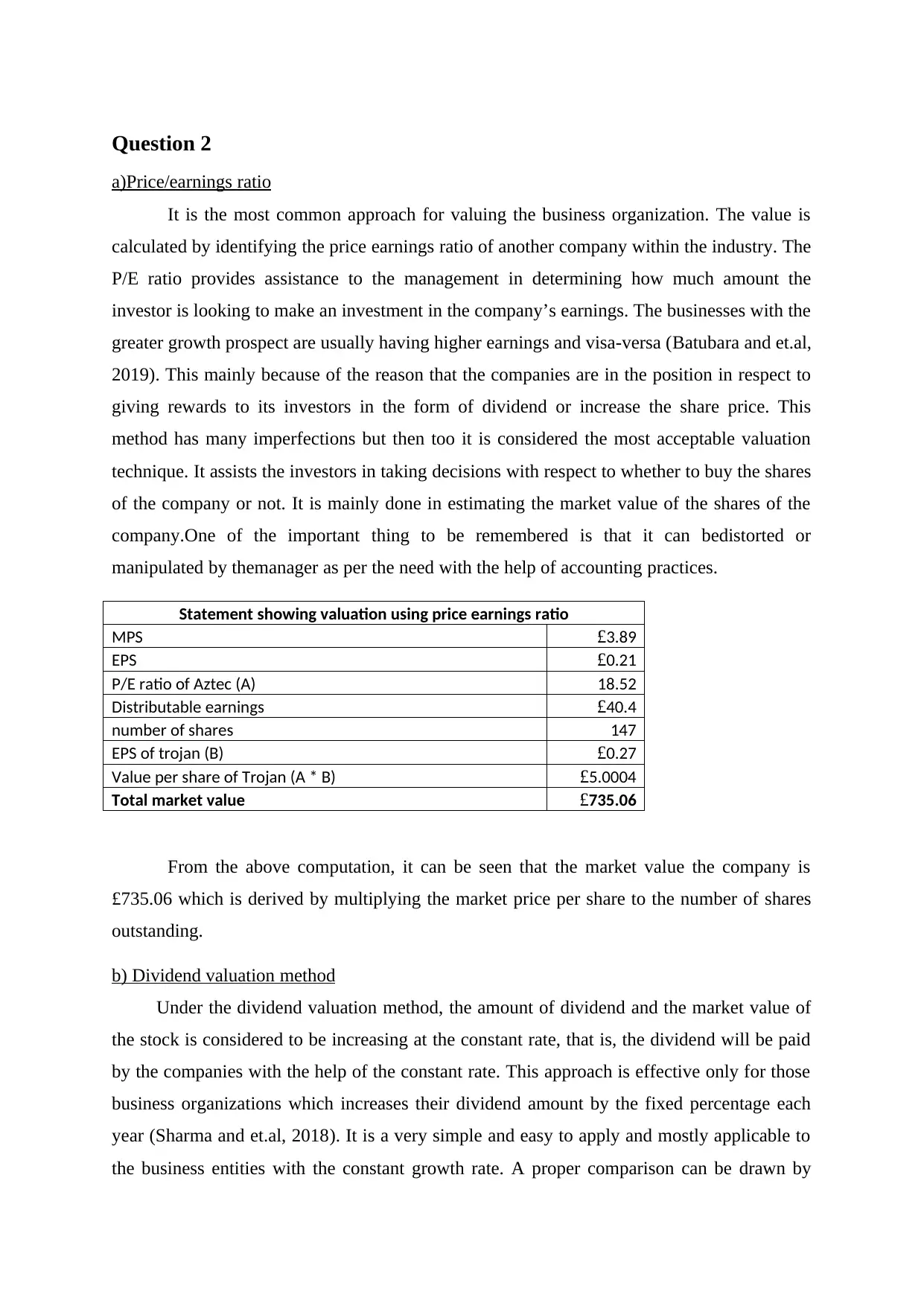
Question 2
a)Price/earnings ratio
It is the most common approach for valuing the business organization. The value is
calculated by identifying the price earnings ratio of another company within the industry. The
P/E ratio provides assistance to the management in determining how much amount the
investor is looking to make an investment in the company’s earnings. The businesses with the
greater growth prospect are usually having higher earnings and visa-versa (Batubara and et.al,
2019). This mainly because of the reason that the companies are in the position in respect to
giving rewards to its investors in the form of dividend or increase the share price. This
method has many imperfections but then too it is considered the most acceptable valuation
technique. It assists the investors in taking decisions with respect to whether to buy the shares
of the company or not. It is mainly done in estimating the market value of the shares of the
company.One of the important thing to be remembered is that it can bedistorted or
manipulated by themanager as per the need with the help of accounting practices.
Statement showing valuation using price earnings ratio
MPS £3.89
EPS £0.21
P/E ratio of Aztec (A) 18.52
Distributable earnings £40.4
number of shares 147
EPS of trojan (B) £0.27
Value per share of Trojan (A * B) £5.0004
Total market value £735.06
From the above computation, it can be seen that the market value the company is
£735.06 which is derived by multiplying the market price per share to the number of shares
outstanding.
b) Dividend valuation method
Under the dividend valuation method, the amount of dividend and the market value of
the stock is considered to be increasing at the constant rate, that is, the dividend will be paid
by the companies with the help of the constant rate. This approach is effective only for those
business organizations which increases their dividend amount by the fixed percentage each
year (Sharma and et.al, 2018). It is a very simple and easy to apply and mostly applicable to
the business entities with the constant growth rate. A proper comparison can be drawn by
a)Price/earnings ratio
It is the most common approach for valuing the business organization. The value is
calculated by identifying the price earnings ratio of another company within the industry. The
P/E ratio provides assistance to the management in determining how much amount the
investor is looking to make an investment in the company’s earnings. The businesses with the
greater growth prospect are usually having higher earnings and visa-versa (Batubara and et.al,
2019). This mainly because of the reason that the companies are in the position in respect to
giving rewards to its investors in the form of dividend or increase the share price. This
method has many imperfections but then too it is considered the most acceptable valuation
technique. It assists the investors in taking decisions with respect to whether to buy the shares
of the company or not. It is mainly done in estimating the market value of the shares of the
company.One of the important thing to be remembered is that it can bedistorted or
manipulated by themanager as per the need with the help of accounting practices.
Statement showing valuation using price earnings ratio
MPS £3.89
EPS £0.21
P/E ratio of Aztec (A) 18.52
Distributable earnings £40.4
number of shares 147
EPS of trojan (B) £0.27
Value per share of Trojan (A * B) £5.0004
Total market value £735.06
From the above computation, it can be seen that the market value the company is
£735.06 which is derived by multiplying the market price per share to the number of shares
outstanding.
b) Dividend valuation method
Under the dividend valuation method, the amount of dividend and the market value of
the stock is considered to be increasing at the constant rate, that is, the dividend will be paid
by the companies with the help of the constant rate. This approach is effective only for those
business organizations which increases their dividend amount by the fixed percentage each
year (Sharma and et.al, 2018). It is a very simple and easy to apply and mostly applicable to
the business entities with the constant growth rate. A proper comparison can be drawn by
⊘ This is a preview!⊘
Do you want full access?
Subscribe today to unlock all pages.

Trusted by 1+ million students worldwide
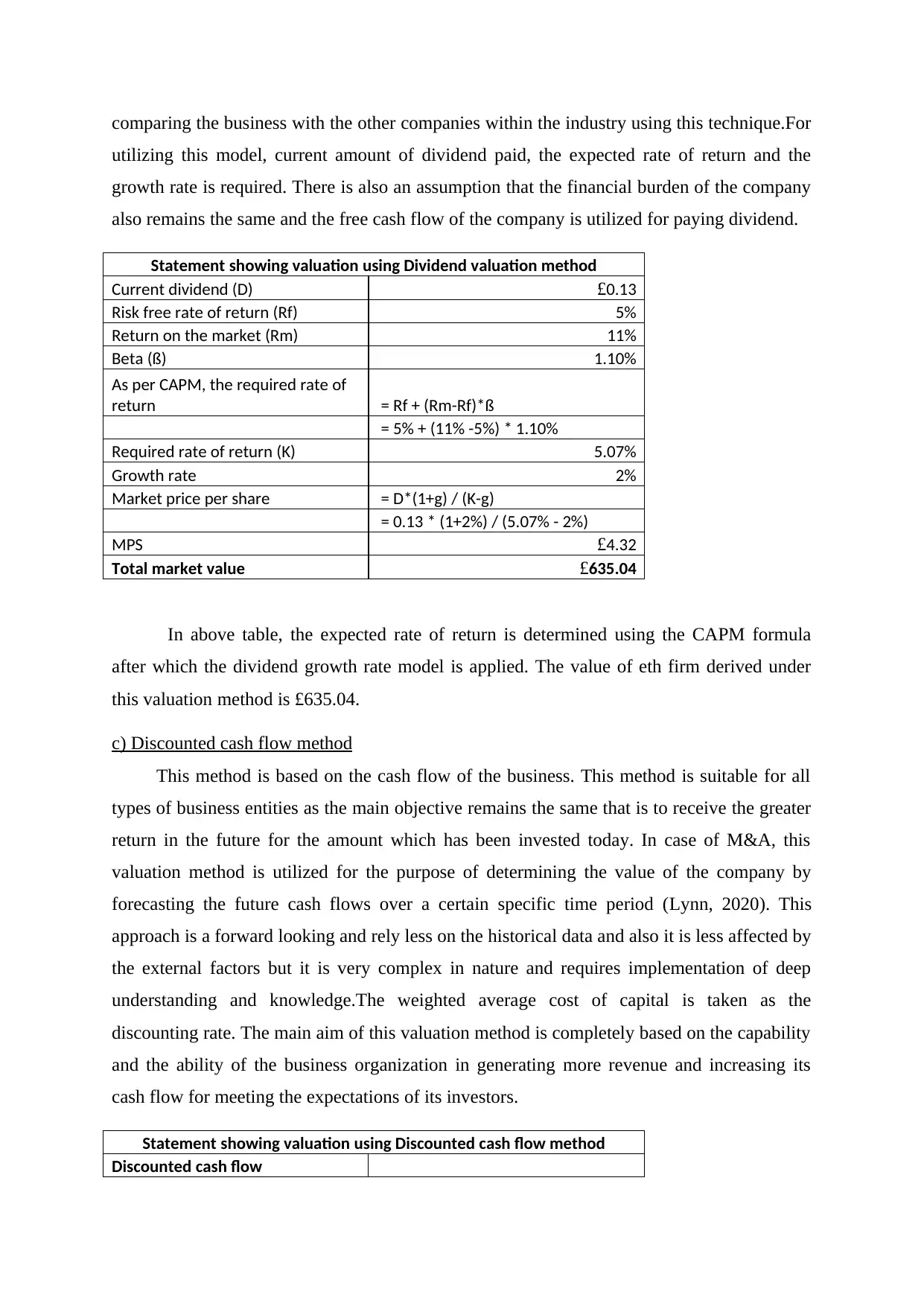
comparing the business with the other companies within the industry using this technique.For
utilizing this model, current amount of dividend paid, the expected rate of return and the
growth rate is required. There is also an assumption that the financial burden of the company
also remains the same and the free cash flow of the company is utilized for paying dividend.
Statement showing valuation using Dividend valuation method
Current dividend (D) £0.13
Risk free rate of return (Rf) 5%
Return on the market (Rm) 11%
Beta (ß) 1.10%
As per CAPM, the required rate of
return = Rf + (Rm-Rf)*ß
= 5% + (11% -5%) * 1.10%
Required rate of return (K) 5.07%
Growth rate 2%
Market price per share = D*(1+g) / (K-g)
= 0.13 * (1+2%) / (5.07% - 2%)
MPS £4.32
Total market value £635.04
In above table, the expected rate of return is determined using the CAPM formula
after which the dividend growth rate model is applied. The value of eth firm derived under
this valuation method is £635.04.
c) Discounted cash flow method
This method is based on the cash flow of the business. This method is suitable for all
types of business entities as the main objective remains the same that is to receive the greater
return in the future for the amount which has been invested today. In case of M&A, this
valuation method is utilized for the purpose of determining the value of the company by
forecasting the future cash flows over a certain specific time period (Lynn, 2020). This
approach is a forward looking and rely less on the historical data and also it is less affected by
the external factors but it is very complex in nature and requires implementation of deep
understanding and knowledge.The weighted average cost of capital is taken as the
discounting rate. The main aim of this valuation method is completely based on the capability
and the ability of the business organization in generating more revenue and increasing its
cash flow for meeting the expectations of its investors.
Statement showing valuation using Discounted cash flow method
Discounted cash flow
utilizing this model, current amount of dividend paid, the expected rate of return and the
growth rate is required. There is also an assumption that the financial burden of the company
also remains the same and the free cash flow of the company is utilized for paying dividend.
Statement showing valuation using Dividend valuation method
Current dividend (D) £0.13
Risk free rate of return (Rf) 5%
Return on the market (Rm) 11%
Beta (ß) 1.10%
As per CAPM, the required rate of
return = Rf + (Rm-Rf)*ß
= 5% + (11% -5%) * 1.10%
Required rate of return (K) 5.07%
Growth rate 2%
Market price per share = D*(1+g) / (K-g)
= 0.13 * (1+2%) / (5.07% - 2%)
MPS £4.32
Total market value £635.04
In above table, the expected rate of return is determined using the CAPM formula
after which the dividend growth rate model is applied. The value of eth firm derived under
this valuation method is £635.04.
c) Discounted cash flow method
This method is based on the cash flow of the business. This method is suitable for all
types of business entities as the main objective remains the same that is to receive the greater
return in the future for the amount which has been invested today. In case of M&A, this
valuation method is utilized for the purpose of determining the value of the company by
forecasting the future cash flows over a certain specific time period (Lynn, 2020). This
approach is a forward looking and rely less on the historical data and also it is less affected by
the external factors but it is very complex in nature and requires implementation of deep
understanding and knowledge.The weighted average cost of capital is taken as the
discounting rate. The main aim of this valuation method is completely based on the capability
and the ability of the business organization in generating more revenue and increasing its
cash flow for meeting the expectations of its investors.
Statement showing valuation using Discounted cash flow method
Discounted cash flow
Paraphrase This Document
Need a fresh take? Get an instant paraphrase of this document with our AI Paraphraser
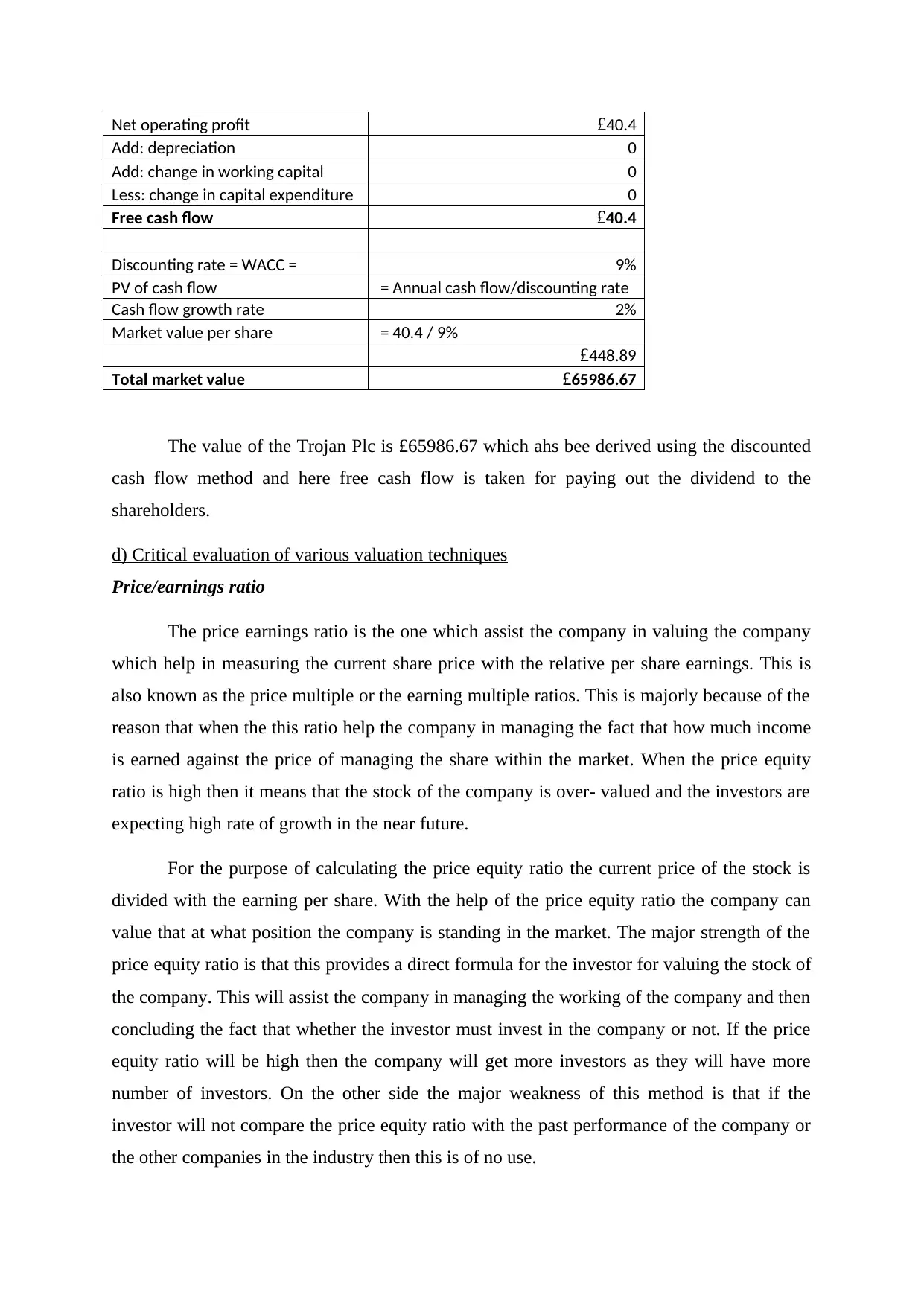
Net operating profit £40.4
Add: depreciation 0
Add: change in working capital 0
Less: change in capital expenditure 0
Free cash flow £40.4
Discounting rate = WACC = 9%
PV of cash flow = Annual cash flow/discounting rate
Cash flow growth rate 2%
Market value per share = 40.4 / 9%
£448.89
Total market value £65986.67
The value of the Trojan Plc is £65986.67 which ahs bee derived using the discounted
cash flow method and here free cash flow is taken for paying out the dividend to the
shareholders.
d) Critical evaluation of various valuation techniques
Price/earnings ratio
The price earnings ratio is the one which assist the company in valuing the company
which help in measuring the current share price with the relative per share earnings. This is
also known as the price multiple or the earning multiple ratios. This is majorly because of the
reason that when the this ratio help the company in managing the fact that how much income
is earned against the price of managing the share within the market. When the price equity
ratio is high then it means that the stock of the company is over- valued and the investors are
expecting high rate of growth in the near future.
For the purpose of calculating the price equity ratio the current price of the stock is
divided with the earning per share. With the help of the price equity ratio the company can
value that at what position the company is standing in the market. The major strength of the
price equity ratio is that this provides a direct formula for the investor for valuing the stock of
the company. This will assist the company in managing the working of the company and then
concluding the fact that whether the investor must invest in the company or not. If the price
equity ratio will be high then the company will get more investors as they will have more
number of investors. On the other side the major weakness of this method is that if the
investor will not compare the price equity ratio with the past performance of the company or
the other companies in the industry then this is of no use.
Add: depreciation 0
Add: change in working capital 0
Less: change in capital expenditure 0
Free cash flow £40.4
Discounting rate = WACC = 9%
PV of cash flow = Annual cash flow/discounting rate
Cash flow growth rate 2%
Market value per share = 40.4 / 9%
£448.89
Total market value £65986.67
The value of the Trojan Plc is £65986.67 which ahs bee derived using the discounted
cash flow method and here free cash flow is taken for paying out the dividend to the
shareholders.
d) Critical evaluation of various valuation techniques
Price/earnings ratio
The price earnings ratio is the one which assist the company in valuing the company
which help in measuring the current share price with the relative per share earnings. This is
also known as the price multiple or the earning multiple ratios. This is majorly because of the
reason that when the this ratio help the company in managing the fact that how much income
is earned against the price of managing the share within the market. When the price equity
ratio is high then it means that the stock of the company is over- valued and the investors are
expecting high rate of growth in the near future.
For the purpose of calculating the price equity ratio the current price of the stock is
divided with the earning per share. With the help of the price equity ratio the company can
value that at what position the company is standing in the market. The major strength of the
price equity ratio is that this provides a direct formula for the investor for valuing the stock of
the company. This will assist the company in managing the working of the company and then
concluding the fact that whether the investor must invest in the company or not. If the price
equity ratio will be high then the company will get more investors as they will have more
number of investors. On the other side the major weakness of this method is that if the
investor will not compare the price equity ratio with the past performance of the company or
the other companies in the industry then this is of no use.

Dividend valuation method
The dividend discount model is the method which is quantitative method for the
valuation of the company stock price which is based on the assumption that current price of
stock is equal to the sum of company’s future dividend discounted back to the present value.
This whole model is developed under the assumption that the intrinsic value of the stock
reflects the fact that present value of the future cash flow is generated by the security (Iachan,
2020). In general terms this model help and provides for a simple method to calculate the
stock price which is fair and which have less variable input.
With the analysis of this model it was found that the major advantage of using this
model is that this is very conservative model for valuing the stock of the company. This is
majorly because of the reason that this model does not require any growth assumptions to be
undertaken for the growth or valuation of the company. In addition to this the major
advantage of using this model is that this is very easy to handle and understand and calculate
the value of the company and the stock price of the company. On the flip side the major
weakness of the company is that this method is applicable over only those stocks which are
paying dividend and not on the remaining stocks. Also, in addition to this the method of
dividend discount model it only values the payment of the dividend as a return on the
investment and not any other income or expense.
Discounted cash flow method
The DCF method arguably the soundest approach of valuation. Since, it is forward
looking and depends upon the future expectations and it is also inward looking as it is relied
most on eth fundamental expectations and is less affected by the volatile external factors. It is
mainly focused on the cash flow generation and is least affected by the accounting
assumptions. But on the other hand, it has certain limitations as well (van Vuuren, 2016).
The accuracy in this approach is dependent on the quality of assumption is made. The
outcome of it is mainly a range of value rather than a single value. This valuation technique
works best in the situation when there is a high degree of confidence with respect to the cash
flow but the firm’s operation may not be able to see it also, it becomes difficult to predict the
sales accurately.
Based on the analysis, it can be said that the price earnings ratio is the most
appropriate method for the business valuation. Since, it is the most common and preferable
method and most of the investors uses this method for taking the investment decisions.
The dividend discount model is the method which is quantitative method for the
valuation of the company stock price which is based on the assumption that current price of
stock is equal to the sum of company’s future dividend discounted back to the present value.
This whole model is developed under the assumption that the intrinsic value of the stock
reflects the fact that present value of the future cash flow is generated by the security (Iachan,
2020). In general terms this model help and provides for a simple method to calculate the
stock price which is fair and which have less variable input.
With the analysis of this model it was found that the major advantage of using this
model is that this is very conservative model for valuing the stock of the company. This is
majorly because of the reason that this model does not require any growth assumptions to be
undertaken for the growth or valuation of the company. In addition to this the major
advantage of using this model is that this is very easy to handle and understand and calculate
the value of the company and the stock price of the company. On the flip side the major
weakness of the company is that this method is applicable over only those stocks which are
paying dividend and not on the remaining stocks. Also, in addition to this the method of
dividend discount model it only values the payment of the dividend as a return on the
investment and not any other income or expense.
Discounted cash flow method
The DCF method arguably the soundest approach of valuation. Since, it is forward
looking and depends upon the future expectations and it is also inward looking as it is relied
most on eth fundamental expectations and is less affected by the volatile external factors. It is
mainly focused on the cash flow generation and is least affected by the accounting
assumptions. But on the other hand, it has certain limitations as well (van Vuuren, 2016).
The accuracy in this approach is dependent on the quality of assumption is made. The
outcome of it is mainly a range of value rather than a single value. This valuation technique
works best in the situation when there is a high degree of confidence with respect to the cash
flow but the firm’s operation may not be able to see it also, it becomes difficult to predict the
sales accurately.
Based on the analysis, it can be said that the price earnings ratio is the most
appropriate method for the business valuation. Since, it is the most common and preferable
method and most of the investors uses this method for taking the investment decisions.
⊘ This is a preview!⊘
Do you want full access?
Subscribe today to unlock all pages.

Trusted by 1+ million students worldwide
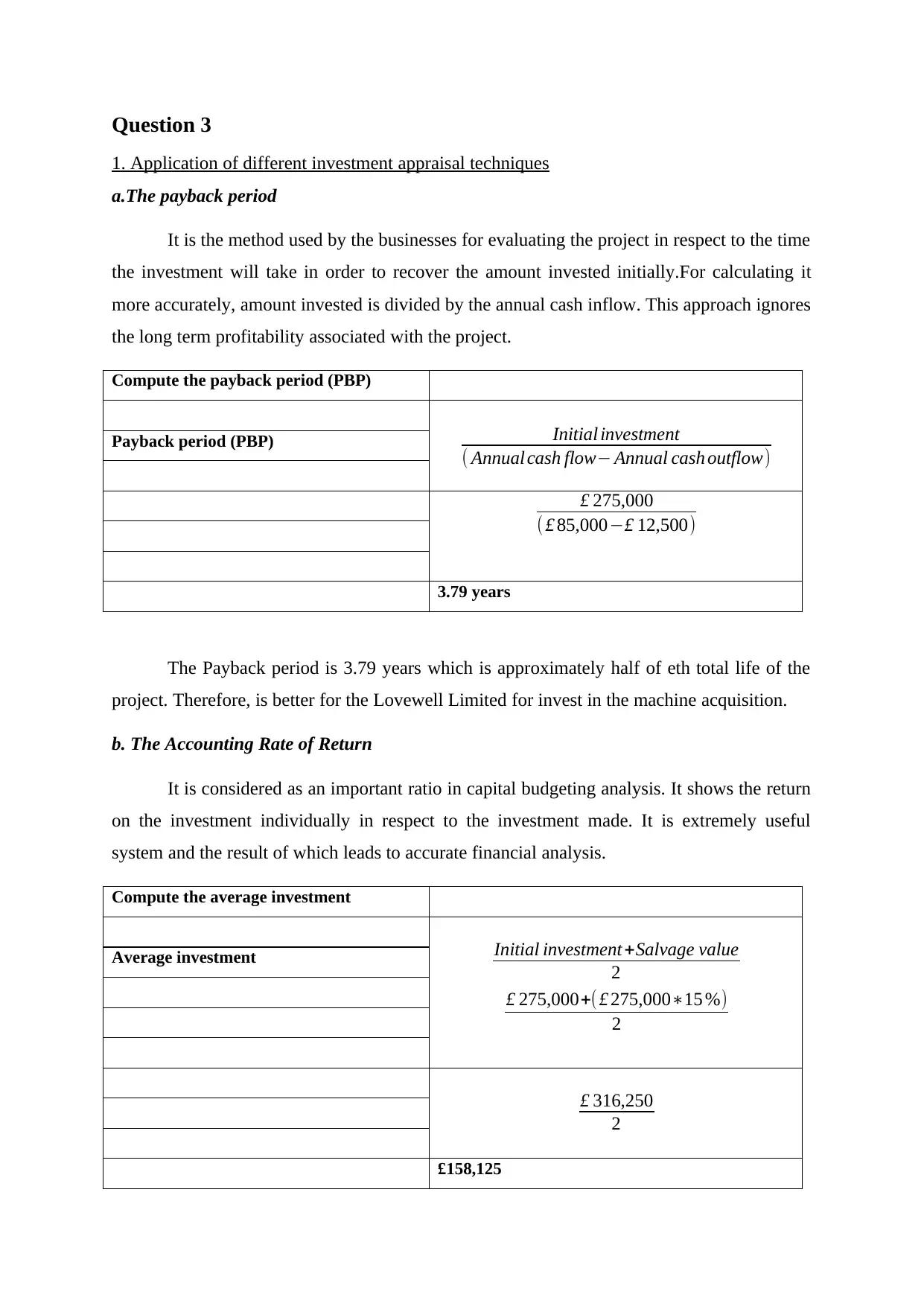
Question 3
1. Application of different investment appraisal techniques
a.The payback period
It is the method used by the businesses for evaluating the project in respect to the time
the investment will take in order to recover the amount invested initially.For calculating it
more accurately, amount invested is divided by the annual cash inflow. This approach ignores
the long term profitability associated with the project.
Compute the payback period (PBP)
Payback period (PBP)
3.79 years
The Payback period is 3.79 years which is approximately half of eth total life of the
project. Therefore, is better for the Lovewell Limited for invest in the machine acquisition.
b. The Accounting Rate of Return
It is considered as an important ratio in capital budgeting analysis. It shows the return
on the investment individually in respect to the investment made. It is extremely useful
system and the result of which leads to accurate financial analysis.
Compute the average investment
Average investment
£158,125
£ 275,000
( £ 85,000−£ 12,500)
Initial investment
( Annual cash flow− Annual cash outflow)
Initial investment +Salvage value
2
£ 275,000+( £ 275,000∗15 %)
2
£ 316,250
2
1. Application of different investment appraisal techniques
a.The payback period
It is the method used by the businesses for evaluating the project in respect to the time
the investment will take in order to recover the amount invested initially.For calculating it
more accurately, amount invested is divided by the annual cash inflow. This approach ignores
the long term profitability associated with the project.
Compute the payback period (PBP)
Payback period (PBP)
3.79 years
The Payback period is 3.79 years which is approximately half of eth total life of the
project. Therefore, is better for the Lovewell Limited for invest in the machine acquisition.
b. The Accounting Rate of Return
It is considered as an important ratio in capital budgeting analysis. It shows the return
on the investment individually in respect to the investment made. It is extremely useful
system and the result of which leads to accurate financial analysis.
Compute the average investment
Average investment
£158,125
£ 275,000
( £ 85,000−£ 12,500)
Initial investment
( Annual cash flow− Annual cash outflow)
Initial investment +Salvage value
2
£ 275,000+( £ 275,000∗15 %)
2
£ 316,250
2
Paraphrase This Document
Need a fresh take? Get an instant paraphrase of this document with our AI Paraphraser
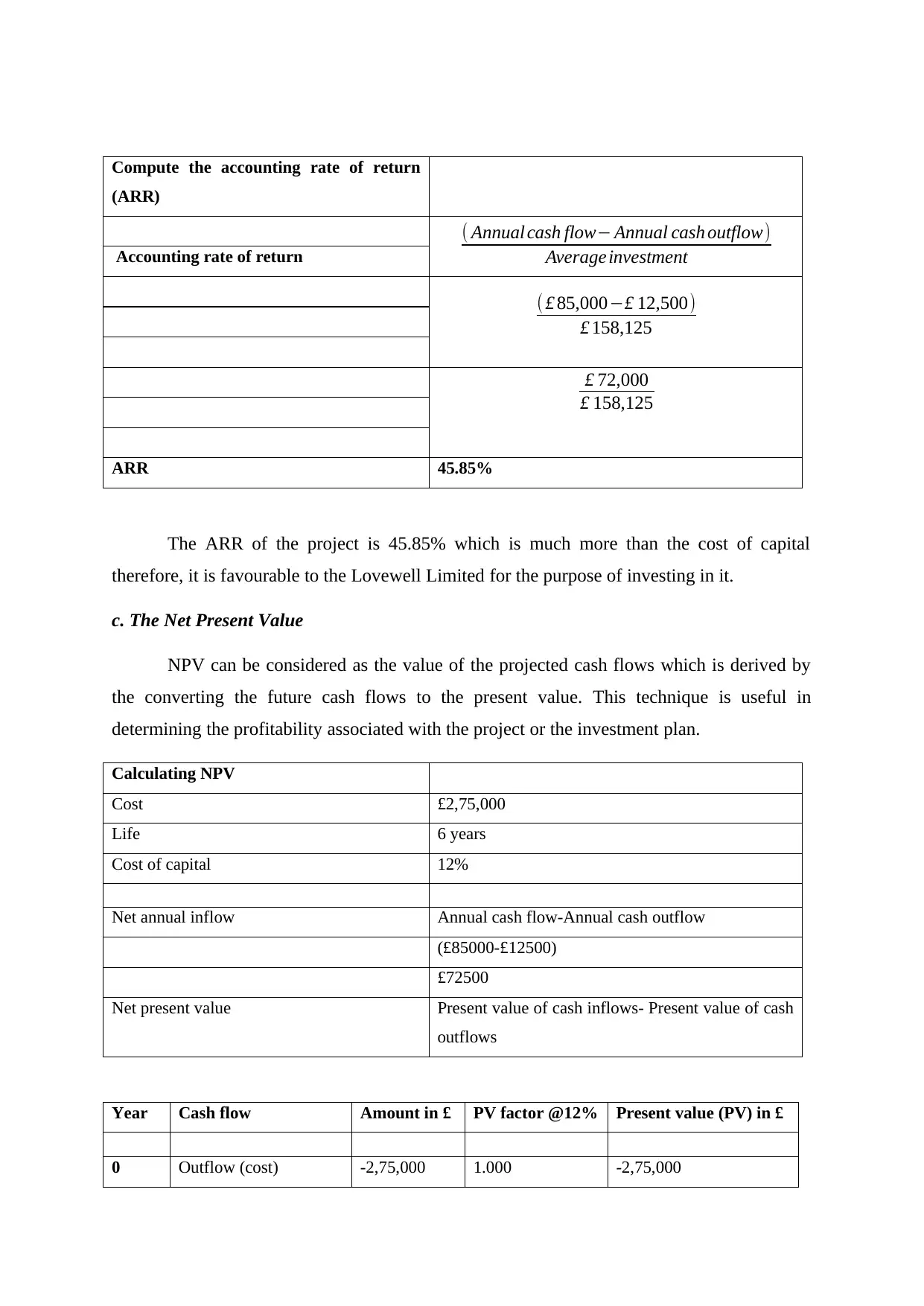
Compute the accounting rate of return
(ARR)
Accounting rate of return
ARR 45.85%
The ARR of the project is 45.85% which is much more than the cost of capital
therefore, it is favourable to the Lovewell Limited for the purpose of investing in it.
c. The Net Present Value
NPV can be considered as the value of the projected cash flows which is derived by
the converting the future cash flows to the present value. This technique is useful in
determining the profitability associated with the project or the investment plan.
Calculating NPV
Cost £2,75,000
Life 6 years
Cost of capital 12%
Net annual inflow Annual cash flow-Annual cash outflow
(£85000-£12500)
£72500
Net present value Present value of cash inflows- Present value of cash
outflows
Year Cash flow Amount in £ PV factor @12% Present value (PV) in £
0 Outflow (cost) -2,75,000 1.000 -2,75,000
( Annual cash flow− Annual cash outflow)
Average investment
( £ 85,000−£ 12,500)
£ 158,125
£ 72,000
£ 158,125
(ARR)
Accounting rate of return
ARR 45.85%
The ARR of the project is 45.85% which is much more than the cost of capital
therefore, it is favourable to the Lovewell Limited for the purpose of investing in it.
c. The Net Present Value
NPV can be considered as the value of the projected cash flows which is derived by
the converting the future cash flows to the present value. This technique is useful in
determining the profitability associated with the project or the investment plan.
Calculating NPV
Cost £2,75,000
Life 6 years
Cost of capital 12%
Net annual inflow Annual cash flow-Annual cash outflow
(£85000-£12500)
£72500
Net present value Present value of cash inflows- Present value of cash
outflows
Year Cash flow Amount in £ PV factor @12% Present value (PV) in £
0 Outflow (cost) -2,75,000 1.000 -2,75,000
( Annual cash flow− Annual cash outflow)
Average investment
( £ 85,000−£ 12,500)
£ 158,125
£ 72,000
£ 158,125
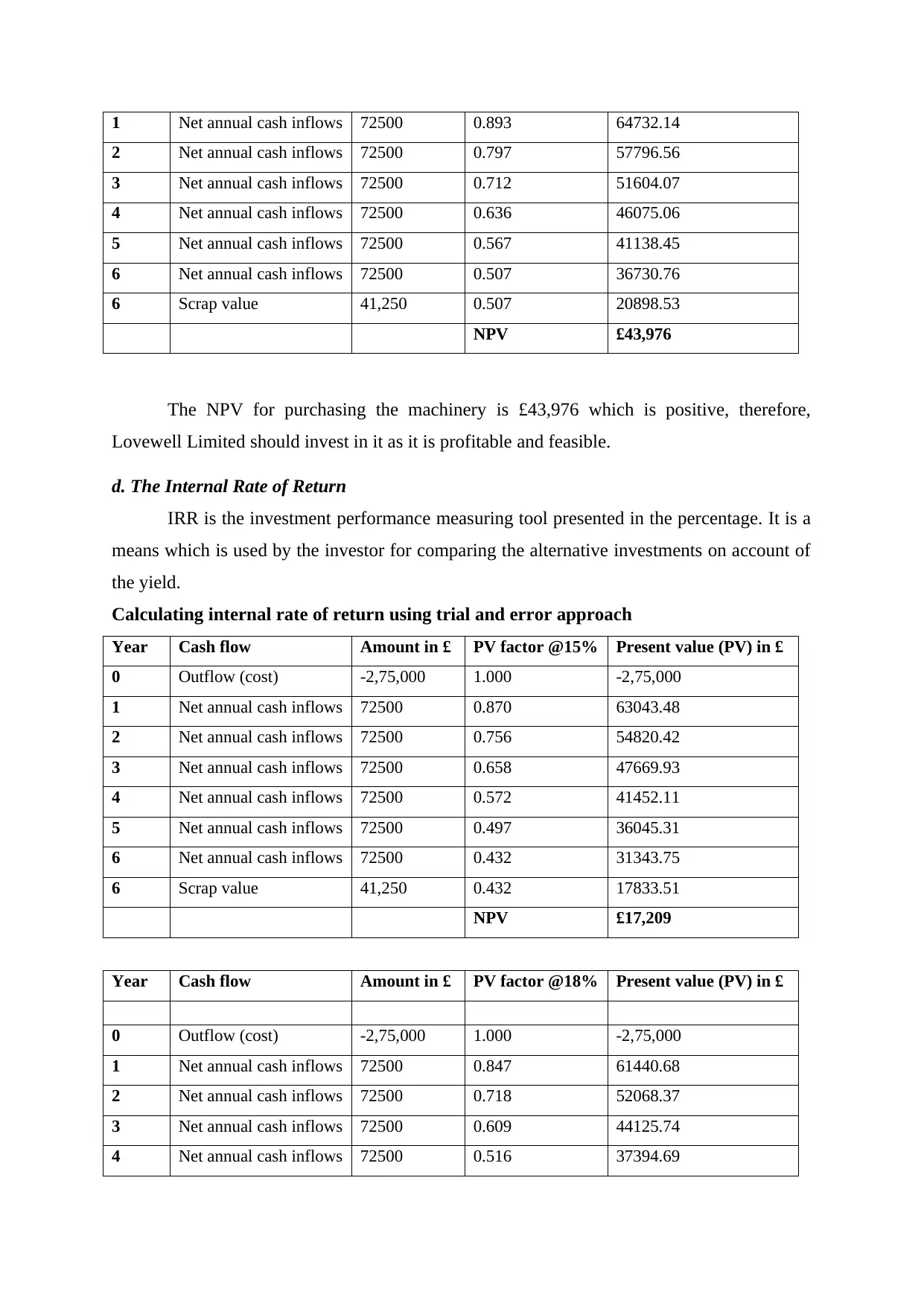
1 Net annual cash inflows 72500 0.893 64732.14
2 Net annual cash inflows 72500 0.797 57796.56
3 Net annual cash inflows 72500 0.712 51604.07
4 Net annual cash inflows 72500 0.636 46075.06
5 Net annual cash inflows 72500 0.567 41138.45
6 Net annual cash inflows 72500 0.507 36730.76
6 Scrap value 41,250 0.507 20898.53
NPV £43,976
The NPV for purchasing the machinery is £43,976 which is positive, therefore,
Lovewell Limited should invest in it as it is profitable and feasible.
d. The Internal Rate of Return
IRR is the investment performance measuring tool presented in the percentage. It is a
means which is used by the investor for comparing the alternative investments on account of
the yield.
Calculating internal rate of return using trial and error approach
Year Cash flow Amount in £ PV factor @15% Present value (PV) in £
0 Outflow (cost) -2,75,000 1.000 -2,75,000
1 Net annual cash inflows 72500 0.870 63043.48
2 Net annual cash inflows 72500 0.756 54820.42
3 Net annual cash inflows 72500 0.658 47669.93
4 Net annual cash inflows 72500 0.572 41452.11
5 Net annual cash inflows 72500 0.497 36045.31
6 Net annual cash inflows 72500 0.432 31343.75
6 Scrap value 41,250 0.432 17833.51
NPV £17,209
Year Cash flow Amount in £ PV factor @18% Present value (PV) in £
0 Outflow (cost) -2,75,000 1.000 -2,75,000
1 Net annual cash inflows 72500 0.847 61440.68
2 Net annual cash inflows 72500 0.718 52068.37
3 Net annual cash inflows 72500 0.609 44125.74
4 Net annual cash inflows 72500 0.516 37394.69
2 Net annual cash inflows 72500 0.797 57796.56
3 Net annual cash inflows 72500 0.712 51604.07
4 Net annual cash inflows 72500 0.636 46075.06
5 Net annual cash inflows 72500 0.567 41138.45
6 Net annual cash inflows 72500 0.507 36730.76
6 Scrap value 41,250 0.507 20898.53
NPV £43,976
The NPV for purchasing the machinery is £43,976 which is positive, therefore,
Lovewell Limited should invest in it as it is profitable and feasible.
d. The Internal Rate of Return
IRR is the investment performance measuring tool presented in the percentage. It is a
means which is used by the investor for comparing the alternative investments on account of
the yield.
Calculating internal rate of return using trial and error approach
Year Cash flow Amount in £ PV factor @15% Present value (PV) in £
0 Outflow (cost) -2,75,000 1.000 -2,75,000
1 Net annual cash inflows 72500 0.870 63043.48
2 Net annual cash inflows 72500 0.756 54820.42
3 Net annual cash inflows 72500 0.658 47669.93
4 Net annual cash inflows 72500 0.572 41452.11
5 Net annual cash inflows 72500 0.497 36045.31
6 Net annual cash inflows 72500 0.432 31343.75
6 Scrap value 41,250 0.432 17833.51
NPV £17,209
Year Cash flow Amount in £ PV factor @18% Present value (PV) in £
0 Outflow (cost) -2,75,000 1.000 -2,75,000
1 Net annual cash inflows 72500 0.847 61440.68
2 Net annual cash inflows 72500 0.718 52068.37
3 Net annual cash inflows 72500 0.609 44125.74
4 Net annual cash inflows 72500 0.516 37394.69
⊘ This is a preview!⊘
Do you want full access?
Subscribe today to unlock all pages.

Trusted by 1+ million students worldwide
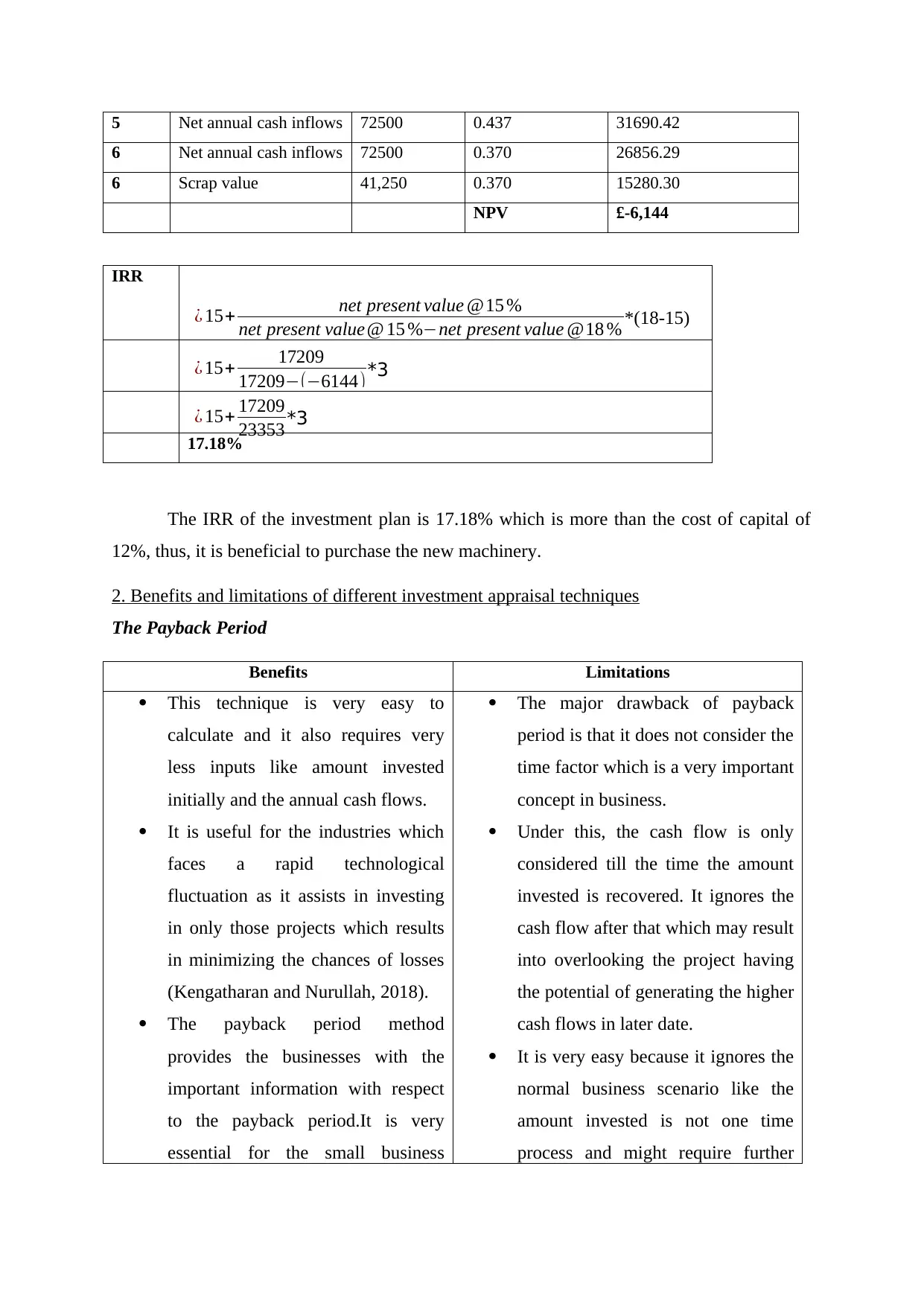
5 Net annual cash inflows 72500 0.437 31690.42
6 Net annual cash inflows 72500 0.370 26856.29
6 Scrap value 41,250 0.370 15280.30
NPV £-6,144
IRR
17.18%
The IRR of the investment plan is 17.18% which is more than the cost of capital of
12%, thus, it is beneficial to purchase the new machinery.
2. Benefits and limitations of different investment appraisal techniques
The Payback Period
Benefits Limitations
This technique is very easy to
calculate and it also requires very
less inputs like amount invested
initially and the annual cash flows.
It is useful for the industries which
faces a rapid technological
fluctuation as it assists in investing
in only those projects which results
in minimizing the chances of losses
(Kengatharan and Nurullah, 2018).
The payback period method
provides the businesses with the
important information with respect
to the payback period.It is very
essential for the small business
The major drawback of payback
period is that it does not consider the
time factor which is a very important
concept in business.
Under this, the cash flow is only
considered till the time the amount
invested is recovered. It ignores the
cash flow after that which may result
into overlooking the project having
the potential of generating the higher
cash flows in later date.
It is very easy because it ignores the
normal business scenario like the
amount invested is not one time
process and might require further
¿ 15+ net present value @15 %
net present value@ 15 %−net present value @18 % *(18-15)
¿ 15+ 17209
17209−(−6144)*3
¿ 15+ 17209
23353 *3
6 Net annual cash inflows 72500 0.370 26856.29
6 Scrap value 41,250 0.370 15280.30
NPV £-6,144
IRR
17.18%
The IRR of the investment plan is 17.18% which is more than the cost of capital of
12%, thus, it is beneficial to purchase the new machinery.
2. Benefits and limitations of different investment appraisal techniques
The Payback Period
Benefits Limitations
This technique is very easy to
calculate and it also requires very
less inputs like amount invested
initially and the annual cash flows.
It is useful for the industries which
faces a rapid technological
fluctuation as it assists in investing
in only those projects which results
in minimizing the chances of losses
(Kengatharan and Nurullah, 2018).
The payback period method
provides the businesses with the
important information with respect
to the payback period.It is very
essential for the small business
The major drawback of payback
period is that it does not consider the
time factor which is a very important
concept in business.
Under this, the cash flow is only
considered till the time the amount
invested is recovered. It ignores the
cash flow after that which may result
into overlooking the project having
the potential of generating the higher
cash flows in later date.
It is very easy because it ignores the
normal business scenario like the
amount invested is not one time
process and might require further
¿ 15+ net present value @15 %
net present value@ 15 %−net present value @18 % *(18-15)
¿ 15+ 17209
17209−(−6144)*3
¿ 15+ 17209
23353 *3
Paraphrase This Document
Need a fresh take? Get an instant paraphrase of this document with our AI Paraphraser
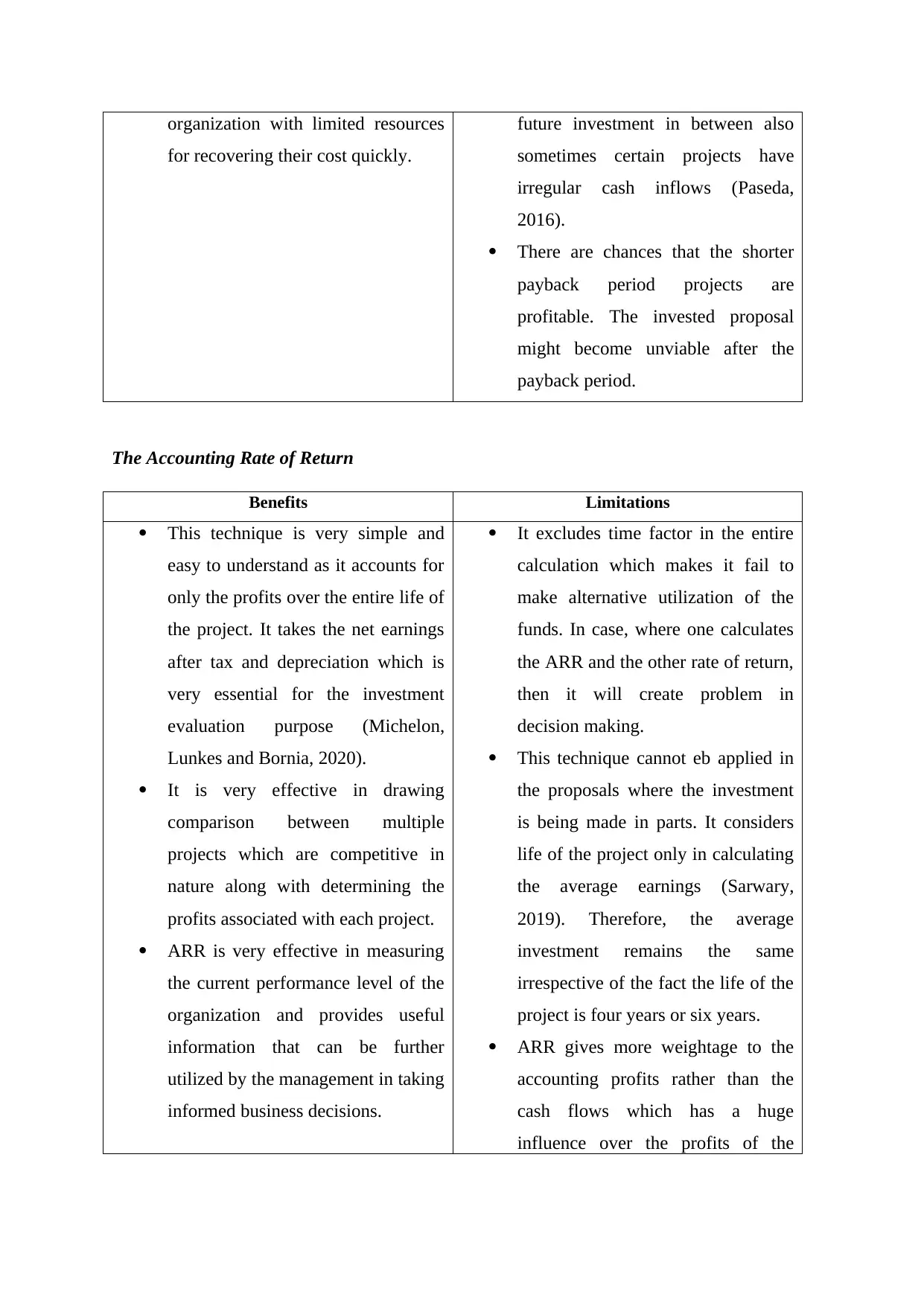
organization with limited resources
for recovering their cost quickly.
future investment in between also
sometimes certain projects have
irregular cash inflows (Paseda,
2016).
There are chances that the shorter
payback period projects are
profitable. The invested proposal
might become unviable after the
payback period.
The Accounting Rate of Return
Benefits Limitations
This technique is very simple and
easy to understand as it accounts for
only the profits over the entire life of
the project. It takes the net earnings
after tax and depreciation which is
very essential for the investment
evaluation purpose (Michelon,
Lunkes and Bornia, 2020).
It is very effective in drawing
comparison between multiple
projects which are competitive in
nature along with determining the
profits associated with each project.
ARR is very effective in measuring
the current performance level of the
organization and provides useful
information that can be further
utilized by the management in taking
informed business decisions.
It excludes time factor in the entire
calculation which makes it fail to
make alternative utilization of the
funds. In case, where one calculates
the ARR and the other rate of return,
then it will create problem in
decision making.
This technique cannot eb applied in
the proposals where the investment
is being made in parts. It considers
life of the project only in calculating
the average earnings (Sarwary,
2019). Therefore, the average
investment remains the same
irrespective of the fact the life of the
project is four years or six years.
ARR gives more weightage to the
accounting profits rather than the
cash flows which has a huge
influence over the profits of the
for recovering their cost quickly.
future investment in between also
sometimes certain projects have
irregular cash inflows (Paseda,
2016).
There are chances that the shorter
payback period projects are
profitable. The invested proposal
might become unviable after the
payback period.
The Accounting Rate of Return
Benefits Limitations
This technique is very simple and
easy to understand as it accounts for
only the profits over the entire life of
the project. It takes the net earnings
after tax and depreciation which is
very essential for the investment
evaluation purpose (Michelon,
Lunkes and Bornia, 2020).
It is very effective in drawing
comparison between multiple
projects which are competitive in
nature along with determining the
profits associated with each project.
ARR is very effective in measuring
the current performance level of the
organization and provides useful
information that can be further
utilized by the management in taking
informed business decisions.
It excludes time factor in the entire
calculation which makes it fail to
make alternative utilization of the
funds. In case, where one calculates
the ARR and the other rate of return,
then it will create problem in
decision making.
This technique cannot eb applied in
the proposals where the investment
is being made in parts. It considers
life of the project only in calculating
the average earnings (Sarwary,
2019). Therefore, the average
investment remains the same
irrespective of the fact the life of the
project is four years or six years.
ARR gives more weightage to the
accounting profits rather than the
cash flows which has a huge
influence over the profits of the

projects.
The Net Present Value
Benefits Limitations
Not like IRR, the NPV is not based
on the assumption that the cash
flows will be invested back at the
IRR.
NPV is a good technique for
measuring the feasibility and
profitability of the project in case
when there are multiple options
(Gianakis, 2017). It utilizes the
discounting rate for the purpose of
determining the viability of the
projects.
The main advantage of it is that it
considers time factors. It also
provides assistance in taking better
and informed decisions not only at
the times when the project size is
same but also when the specific
project is making profits or not.
The NPV is determined using the
discounting rate which is completely
on the managementasthere is no set
guidelines with respect to rates. This
may result into inaccurate
computation of NPV. Also, the rate
cannot be changed and it remains
same throughout the life of the
project.
It is not useful in comparing the
projects which are of different sizes
a sit is presented in the absolute
terms and the NPV of the large
project is usually higher in
comparison to the small size project
(Sinha and Datta, 2020).
The NPV only considers the cash
inflows and cash outflows and
ignores the other hidden cost in
relation to the particular project.
The Internal Rate of Return
Benefits Limitations
It takes into account the time factor
irrespective of the fact whether the
cash flow is equal or unequal
throughout the life of the project.
Under this, the profitability is
This method is based on the
assumption that the earnings from
the investment will be reinvested at
IRR for the left out life of the
project, also, if the ARR is not close
The Net Present Value
Benefits Limitations
Not like IRR, the NPV is not based
on the assumption that the cash
flows will be invested back at the
IRR.
NPV is a good technique for
measuring the feasibility and
profitability of the project in case
when there are multiple options
(Gianakis, 2017). It utilizes the
discounting rate for the purpose of
determining the viability of the
projects.
The main advantage of it is that it
considers time factors. It also
provides assistance in taking better
and informed decisions not only at
the times when the project size is
same but also when the specific
project is making profits or not.
The NPV is determined using the
discounting rate which is completely
on the managementasthere is no set
guidelines with respect to rates. This
may result into inaccurate
computation of NPV. Also, the rate
cannot be changed and it remains
same throughout the life of the
project.
It is not useful in comparing the
projects which are of different sizes
a sit is presented in the absolute
terms and the NPV of the large
project is usually higher in
comparison to the small size project
(Sinha and Datta, 2020).
The NPV only considers the cash
inflows and cash outflows and
ignores the other hidden cost in
relation to the particular project.
The Internal Rate of Return
Benefits Limitations
It takes into account the time factor
irrespective of the fact whether the
cash flow is equal or unequal
throughout the life of the project.
Under this, the profitability is
This method is based on the
assumption that the earnings from
the investment will be reinvested at
IRR for the left out life of the
project, also, if the ARR is not close
⊘ This is a preview!⊘
Do you want full access?
Subscribe today to unlock all pages.

Trusted by 1+ million students worldwide
1 out of 15
Related Documents
Your All-in-One AI-Powered Toolkit for Academic Success.
+13062052269
info@desklib.com
Available 24*7 on WhatsApp / Email
![[object Object]](/_next/static/media/star-bottom.7253800d.svg)
Unlock your academic potential
Copyright © 2020–2025 A2Z Services. All Rights Reserved. Developed and managed by ZUCOL.





